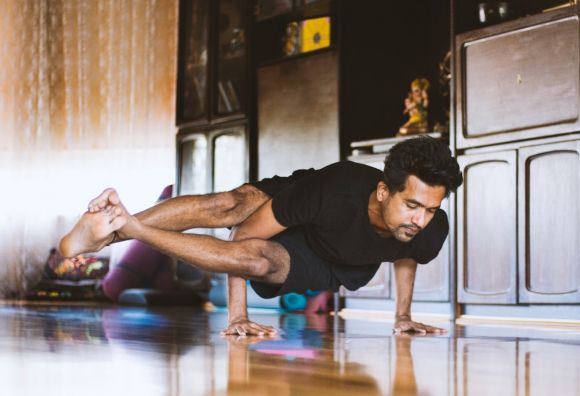Are you feeling tired, drained, and in need of a boost? Look no further than yoga flows to invigorate your body and rejuvenate your mind. Yoga is not just a physical exercise; it is a holistic practice that combines movement, breath, and meditation to promote overall well-being. In this article, we will explore how yoga flows can help you increase your energy levels and bring vitality back into your life.
Blog Posts
A strong and healthy heart is essential for overall well-being. Regular cardiovascular exercise is one of the best ways to keep your heart strong and functioning optimally. In this article, we will explore some of the most effective cardiovascular exercises that can help you achieve a strong heart.
Running: The Ultimate Cardio Workout
Running is a classic cardiovascular exercise that provides numerous benefits for the heart. Whether you prefer jogging or sprinting, running engages multiple muscle groups and increases heart rate, leading to improved cardiovascular fitness. It also helps burn calories, contributing to weight management and reducing the risk of heart disease.Cycling: Pedal Your Way to a Strong Heart
Cycling is a low-impact exercise that is gentle on the joints while offering great cardiovascular benefits. Whether you choose outdoor cycling or indoor spinning classes, this exercise increases heart rate, improves lung capacity, and strengthens leg muscles. Cycling regularly can also help lower blood pressure and improve overall cardiovascular health.Swimming: Dive Into Heart Health
Swimming is a fantastic full-body exercise that provides a great cardiovascular workout. It engages all major muscle groups, including the heart, to improve endurance and cardiovascular fitness. Swimming is particularly beneficial for individuals with joint issues, as it is a low-impact exercise that puts minimal stress on the joints. It also helps improve lung capacity and promotes overall cardiovascular health.Jumping Rope: A Fun and Effective Cardio Exercise
Jumping rope is not just for kids! It is a highly effective cardiovascular exercise that can be done anywhere and requires minimal equipment. Jumping rope increases heart rate, improves coordination, and strengthens muscles in the lower body. It is also a fantastic calorie-burning exercise that can help with weight management and reduce the risk of heart disease.High-Intensity Interval Training (HIIT): Maximum Results in Minimum Time
High-intensity interval training (HIIT) is a form of cardiovascular exercise that involves short bursts of intense exercise followed by active recovery periods. It is an efficient way to improve cardiovascular fitness, as it elevates heart rate and burns calories in a short amount of time. HIIT workouts can be tailored to individual fitness levels and can be done with various exercises, such as running, cycling, or bodyweight exercises.Dancing: Groove Your Way to a Healthy Heart
Dancing is a fun and enjoyable way to get your heart pumping. Whether you prefer salsa, hip-hop, or Zumba, dancing provides a great cardiovascular workout. It improves cardiovascular fitness, coordination, and flexibility. Dancing also releases endorphins, which can boost mood and reduce stress, further benefiting heart health.Incorporating Cardiovascular Exercises Into Your Routine
To reap the benefits of cardiovascular exercise, it is important to incorporate it into your routine consistently. Aim for at least 150 minutes of moderate-intensity cardiovascular exercise or 75 minutes of vigorous-intensity exercise per week. You can break this down into shorter sessions throughout the week to make it more manageable. Remember to warm up before starting any cardiovascular exercise and cool down afterward to prevent injury and promote recovery. It is also essential to listen to your body and gradually increase the intensity and duration of your workouts over time. In conclusion, cardiovascular exercises are crucial for maintaining a strong and healthy heart. Running, cycling, swimming, jumping rope, HIIT, and dancing are all excellent options for improving cardiovascular fitness and overall heart health. Find the exercises that you enjoy the most and make them a regular part of your routine. Your heart will thank you for it!
Getting the most out of your workouts is a goal shared by many fitness enthusiasts. Whether you're looking to build muscle, lose weight, or improve overall fitness, optimizing your workouts is essential. Fit on, an innovative fitness app, can help you achieve your fitness goals faster and more efficiently. In this article, we will explore how you can optimize your workouts using Fit on.
1. Set Clear Goals
Before starting any workout program, it's important to set clear goals. Whether you want to increase strength, improve endurance, or lose a specific amount of weight, having a clear goal in mind will help you stay focused and motivated. Fit on allows you to set personalized goals based on your fitness level and preferences, ensuring that your workouts are tailored to your specific needs.2. Plan Your Workouts
Planning your workouts in advance is crucial for optimizing your results. Fit on offers a wide range of workout programs and schedules that you can customize to fit your lifestyle. By planning your workouts ahead of time, you can ensure that you have a balanced routine that targets all muscle groups and allows for proper recovery.3. Track Your Progress
Tracking your progress is essential for staying motivated and monitoring your results. Fit on provides a comprehensive tracking feature that allows you to log your workouts, track your progress, and set reminders for upcoming workouts. By regularly reviewing your progress, you can make necessary adjustments to your workouts and ensure that you're on track to meet your goals.4. Focus on Proper Form
Proper form is crucial for maximizing the effectiveness of your workouts and preventing injuries. Fit on offers instructional videos and guidance on proper form for each exercise, ensuring that you perform each movement correctly. By focusing on proper form, you can target the intended muscles and avoid unnecessary strain on your joints.5. Incorporate Variety
Adding variety to your workouts is important to prevent boredom and plateauing. Fit on offers a wide variety of workout programs, ranging from strength training and cardio to yoga and Pilates. By incorporating different types of workouts into your routine, you can challenge your muscles in new ways and continue to make progress.6. Listen to Your Body
Listening to your body is crucial for avoiding overtraining and injuries. Fit on provides personalized recommendations based on your fitness level and feedback. If you're feeling fatigued or experiencing pain, it's important to take a rest day or modify your workouts accordingly. By honoring your body's signals, you can prevent setbacks and maintain a consistent workout routine.7. Stay Consistent
Consistency is key when it comes to optimizing your workouts. Fit on offers a built-in scheduling feature that allows you to plan your workouts in advance and set reminders. By staying consistent with your workouts, you can build momentum, make progress, and achieve your fitness goals. In conclusion, optimizing your workouts for maximum results is possible with Fit on. By setting clear goals, planning your workouts, tracking your progress, focusing on proper form, incorporating variety, listening to your body, and staying consistent, you can make the most out of your fitness journey. So why wait? Download Fit on today and start optimizing your workouts for maximum results.
If you're looking to tone your upper body but don't have access to weights or a gym, don't worry! There are plenty of effective exercises you can do right at home that will help you sculpt your arms, shoulders, and back. In this article, we'll explore some of the best exercises to tone your upper body without the use of weights.
Push-Ups: The Ultimate Upper Body Exercise
Push-ups are an excellent exercise that targets multiple muscle groups in your upper body, including your chest, shoulders, and triceps. To perform a push-up, start in a plank position with your hands slightly wider than shoulder-width apart. Lower your body down by bending your elbows, keeping your back straight. Push back up to the starting position and repeat. If you find traditional push-ups too challenging, you can modify the exercise by performing them on your knees or against a wall.Plank Variations for a Strong Core
Planks are another fantastic exercise that not only works your core but also engages your arms, shoulders, and back. To do a basic plank, start by lying face-down on the floor. Lift yourself up by placing your forearms on the ground, elbows directly under your shoulders. Your body should form a straight line from your head to your heels. Hold this position for as long as you can, aiming for at least 30 seconds. For an added challenge, try side planks or plank shoulder taps.Dips for Defined Triceps
Dips are an effective exercise for targeting your triceps, the muscles on the back of your upper arms. To do dips, find a sturdy chair or bench. Sit on the edge with your hands gripping the edge of the seat, fingers facing forward. Walk your feet forward, sliding your hips off the edge. Lower your body down by bending your elbows until your upper arms are parallel to the floor. Push back up to the starting position and repeat. If you find dips too challenging, you can modify the exercise by bending your knees and keeping your feet on the ground.Superman for a Strong Back
The Superman exercise targets your back and helps improve posture. To do a Superman, lie face-down on the floor with your arms extended overhead and your legs straight. Simultaneously lift your arms, chest, and legs off the ground while keeping your head and neck aligned with your spine. Hold this position for a few seconds, then lower back down and repeat. To make it more challenging, try lifting one arm and the opposite leg at the same time.Renegade Rows for Sculpted Shoulders
Renegade rows are a compound exercise that engages multiple muscle groups, including your shoulders, back, and core. Start in a push-up position with your hands gripping a pair of dumbbells or water bottles. Keeping your core engaged, lift one dumbbell off the ground, pulling your elbow up towards your ribs. Lower it back down and repeat on the other side. Make sure to keep your hips level throughout the exercise. In conclusion, you don't need weights to tone your upper body. By incorporating exercises like push-ups, planks, dips, supermans, and renegade rows into your routine, you can strengthen and sculpt your arms, shoulders, and back right from the comfort of your own home. So grab a mat and get started on your journey to a toned upper body today!
Do you often find yourself feeling stiff and tight? Are you looking to improve your flexibility and overall mobility? Look no further! The Fit on Stretching Challenge is here to help you unlock your body's flexibility potential and take your fitness journey to new heights. With a series of targeted stretching exercises, this challenge will not only improve your range of motion but also enhance your athletic performance and reduce the risk of injuries. Are you ready to take the plunge and become more flexible? Let's dive right in!
Understanding the Importance of Stretching
Before we delve into the Fit on Stretching Challenge, it's essential to understand why stretching is crucial for your overall well-being. Stretching exercises help to lengthen and loosen your muscles, tendons, and ligaments, improving their elasticity and reducing stiffness. Regular stretching also increases blood flow to your muscles, which can help alleviate muscle soreness and aid in recovery after intense workouts. Additionally, stretching can improve your posture, enhance your balance and coordination, and relieve tension and stress.The Fit on Stretching Challenge: Week by Week
Week 1: Full Body Warm-up
To kickstart the Fit on Stretching Challenge, we begin with a full-body warm-up. This week focuses on gentle stretches that target major muscle groups and prepare your body for more intense stretching in the following weeks. Remember to listen to your body and not push beyond your limits.Week 2: Upper Body Flexibility
In week 2, we shift our focus to improving upper body flexibility. This includes stretching exercises for your shoulders, chest, back, and arms. These stretches will not only enhance your range of motion but also help to alleviate tension and improve posture.Week 3: Lower Body Flexibility
Moving on to week 3, we concentrate on improving lower body flexibility. This week's stretching exercises target your hips, hamstrings, quads, calves, and ankles. By increasing the flexibility in your lower body, you'll experience improved athletic performance, reduced muscle imbalances, and a decreased risk of lower body injuries.Week 4: Core and Spine Mobility
A strong core and a flexible spine are essential for overall mobility and stability. In week 4, we introduce stretching exercises that focus on your core muscles and spinal mobility. By incorporating core and spine stretches into your routine, you'll enhance your posture, reduce back pain, and improve your overall functional fitness.Week 5: Yoga Flow
In the final week of the Fit on Stretching Challenge, we bring it all together with a yoga flow sequence. This sequence combines various stretching exercises in a fluid and dynamic way, promoting flexibility, balance, and relaxation. Yoga not only helps to improve physical flexibility but also cultivates mental clarity and mindfulness.Maintaining Flexibility Beyond the Challenge
Congratulations! You have successfully completed the Fit on Stretching Challenge and unlocked your flexibility potential. But the journey doesn't end here. To maintain your newfound flexibility, it's important to incorporate regular stretching into your fitness routine. Aim to dedicate at least 10-15 minutes every day to stretch your major muscle groups. Remember to warm up your body before stretching and hold each stretch for 15-30 seconds, focusing on deep breathing and relaxation. In conclusion, the Fit on Stretching Challenge is your ticket to unlocking your body's flexibility potential. By committing to this challenge and incorporating regular stretching into your fitness routine, you'll not only improve your flexibility but also enhance your overall athletic performance, reduce the risk of injuries, and promote a sense of well-being. So, are you ready to take the leap and become more flexible? Join the Fit on Stretching Challenge today and embark on your journey to a more flexible and mobile you!
In today's world, where we are constantly bombarded with advertisements and marketing gimmicks, it can be challenging to make informed choices about the food we eat. However, one effective way to cut through the noise and understand what we are putting into our bodies is by reading food labels. By deciphering the information on food labels, we can make healthier choices and take control of our diet. In this article, we will guide you on how to read food labels like a pro.
Understanding Serving Sizes
One of the first things you should pay attention to on a food label is the serving size. Many people overlook this crucial information and end up consuming more calories or nutrients than they realize. The serving size is usually listed at the top of the label and represents the recommended portion for an average adult. Be sure to check the serving size and adjust your intake accordingly.Check the Ingredients List
The ingredients list is where you can find valuable information about the contents of the food product. It is listed in descending order by weight, meaning that the first ingredient is the most prominent in the product. Look out for keywords like "high fructose corn syrup," "partially hydrogenated oils," or "artificial flavors," as these can be indicators of unhealthy ingredients. If the list is long and contains hard-to-pronounce ingredients, it's best to avoid such products.Pay Attention to Nutrient Content
The nutrient content section of a food label provides vital information about the nutritional value of the product. Look for the following key nutrients: 1. Calories: This indicates the amount of energy provided by the food. Make sure to consider the serving size when assessing the calorie content. 2. Total Fat: Keep an eye on the total fat content and aim for products with lower amounts of saturated and trans fats, as these are considered less healthy. 3. Sodium: Excess sodium intake can contribute to high blood pressure. Be mindful of the sodium content, especially if you have any dietary restrictions or health concerns. 4. Carbohydrates: Carbohydrates provide energy, but it's important to differentiate between complex carbohydrates (found in whole grains and vegetables) and simple carbohydrates (found in sugars and processed foods). 5. Fiber: Look for foods that are high in dietary fiber, as it aids digestion and helps maintain a healthy weight. 6. Protein: Protein is an essential macronutrient that supports muscle growth and repair. Ensure that the product contains an adequate amount of protein.Understanding Food Claims and Symbols
Food labels often feature various claims and symbols to attract consumers. However, it's important to understand what these claims truly mean. For example, a product labeled as "low fat" may still contain a significant amount of calories from other sources such as sugar. Be critical of such claims and cross-reference them with the actual nutritional information on the label.The Importance of Comparing Labels
To make informed decisions, it's crucial to compare food labels. Don't settle for the first product you come across; take the time to compare similar products and choose the one with the best nutritional profile. Pay attention to not only the macronutrients but also the micronutrients, such as vitamins and minerals, as they play a vital role in overall health.Conclusion: Empowering Yourself Through Food Labels
Reading food labels may seem overwhelming at first, but with practice, it becomes second nature. By understanding serving sizes, checking the ingredients list, paying attention to nutrient content, and deciphering food claims, you can make informed choices about the food you consume. Remember, your health is in your hands, and reading food labels like a pro is one of the most powerful tools you have to take control of your diet and lead a healthier lifestyle.
Exercise is an essential part of a healthy lifestyle, but it can also come with the risk of injuries. Whether you are new to working out or a seasoned fitness enthusiast, it is important to take proper precautions to prevent and manage workout injuries. By following these tips, you can stay safe and injury-free while achieving your fitness goals.
1. Warm-up and Stretch
Before diving into your workout, it is crucial to warm up your muscles and prepare your body for the physical activity ahead. Start with a few minutes of light cardio, such as jogging or jumping jacks, to get your blood flowing. Then, focus on dynamic stretching to improve your range of motion and loosen up tight muscles. Dynamic stretches, like walking lunges or arm circles, mimic the movements you will be doing during your workout and help prevent strains or pulls.2. Use Proper Form
Using proper form while exercising is vital for preventing injuries. Whether you are lifting weights, doing yoga poses, or running, make sure to maintain proper alignment and technique. If you are unsure about the correct form, seek guidance from a qualified trainer or instructor. Poor form can put unnecessary stress on your joints and muscles, increasing the risk of injury.3. Gradually Increase Intensity
One of the most common mistakes people make is pushing themselves too hard, too soon. It is important to gradually increase the intensity and duration of your workouts to allow your body to adapt and become stronger. This applies to both cardiovascular exercises and strength training. Listen to your body and give it time to recover between workouts. Overtraining can lead to fatigue, muscle imbalances, and ultimately, injuries.4. Include Rest Days
Rest days are just as important as workout days. Your body needs time to repair and rebuild, especially after intense physical activity. Plan rest days into your exercise routine to give your muscles time to recover. You can still be active on your rest days by engaging in low-impact activities such as walking or stretching. Remember, rest is an essential component of any effective fitness program.5. Cross-Train
Cross-training involves incorporating a variety of exercises into your routine. By diversifying your workouts, you can reduce the risk of overuse injuries caused by repetitive motions. For example, if you are an avid runner, try adding strength training or swimming to your weekly routine. This not only helps prevent injuries but also improves overall fitness and prevents boredom.6. Listen to Your Body
Your body is an excellent indicator of how much stress it can handle. Pay attention to any warning signs such as pain, discomfort, or fatigue. Pushing through pain can lead to more severe injuries, so it is important to listen to your body and modify or stop your workout if necessary. If you experience persistent or severe pain, it is advisable to seek medical attention.7. Stay Hydrated and Fuel Up
Proper hydration and nutrition are crucial for optimal performance and injury prevention. Drink plenty of water before, during, and after your workouts to stay hydrated. Additionally, fuel your body with a balanced diet that includes carbohydrates, protein, and healthy fats. These nutrients provide the energy and nutrients needed for muscle repair and growth. In conclusion, preventing and managing workout injuries requires a combination of proper preparation, technique, and self-awareness. By following these tips and incorporating them into your fitness routine, you can reduce the risk of injuries and enjoy a safe and effective workout experience. Remember, your health and well-being should always be the top priority when engaging in physical activity.
Physical exercise has long been recognized as beneficial for the body, but did you know that it also has a profound impact on the health of your brain? Numerous scientific studies have shown a strong link between cardiovascular exercises and brain health. In this article, we will explore the various ways in which engaging in regular cardiovascular exercises can improve your cognitive function and overall brain health.
Increased Blood Flow to the Brain
When you engage in cardiovascular exercises such as running, swimming, or cycling, your heart rate increases, leading to improved blood circulation throughout your body, including your brain. This increased blood flow delivers essential nutrients and oxygen to your brain cells, promoting their growth and function. Furthermore, cardiovascular exercises stimulate the production of new blood vessels in the brain, a process known as angiogenesis. This increased vascularization enhances the brain's ability to receive nutrients and remove waste products, resulting in improved cognitive function and overall brain health.Enhanced Brain Plasticity
Another way in which cardiovascular exercises benefit brain health is by enhancing brain plasticity. Brain plasticity refers to the brain's ability to adapt and change in response to new experiences and learning. Research has shown that regular cardiovascular exercises promote the release of various growth factors in the brain, such as brain-derived neurotrophic factor (BDNF). These growth factors play a crucial role in the growth and survival of brain cells, as well as in the formation of new connections between them. By increasing brain plasticity, cardiovascular exercises can improve learning, memory, and cognitive abilities.Reduced Risk of Cognitive Decline
As we age, the risk of cognitive decline and neurodegenerative diseases such as Alzheimer's and dementia increases. However, engaging in regular cardiovascular exercises can help reduce this risk. Studies have found that individuals who participate in aerobic exercises have a lower risk of developing cognitive decline and Alzheimer's disease compared to those who lead sedentary lifestyles. The mechanisms behind this protective effect are believed to be related to the increased blood flow and enhanced brain plasticity mentioned earlier. Additionally, cardiovascular exercises have been shown to reduce inflammation in the brain, a key driver of neurodegenerative diseases. By reducing inflammation, these exercises help protect brain cells and preserve cognitive function.Improved Mood and Mental Well-being
In addition to the physical benefits, cardiovascular exercises also have a positive impact on mental health and well-being. Engaging in these exercises releases endorphins, natural chemicals in the brain that promote feelings of happiness and euphoria. Regular participation in cardiovascular exercises has been shown to reduce symptoms of depression and anxiety, improve sleep quality, and boost overall mood. This improved mental well-being can have a profound impact on brain health, as chronic stress and negative emotions have been linked to cognitive decline and increased risk of neurodegenerative diseases. In conclusion, The link between cardiovascular exercises and brain health is undeniable. By increasing blood flow to the brain, enhancing brain plasticity, reducing the risk of cognitive decline, and improving mood and mental well-being, these exercises provide numerous benefits to the brain. Incorporating regular cardiovascular exercises into your daily routine can help maintain a healthy brain and protect against age-related cognitive decline. So, whether it's going for a run, taking a swim, or cycling, make sure to prioritize cardiovascular exercises for the sake of your brain health. Your brain will thank you for it!
Are you looking to take your sports performance to the next level? Look no further than Fit On's online training programs. With their expert guidance and tailored workouts, you can achieve your goals and become a better athlete. In this article, we will explore how Fit On's online training programs can enhance your sports performance.
Customized Training Plans
One of the biggest advantages of Fit On's online training programs is the ability to receive customized training plans. No two athletes are the same, and each sport requires specific skills and conditioning. Fit On understands this and creates personalized training plans to suit your individual needs. Whether you're a runner, a basketball player, or a swimmer, Fit On's trainers will design a program that targets the key areas of your sport. They take into consideration your current fitness level, strengths, weaknesses, and goals. This personalized approach ensures that you are training in a way that maximizes your potential and improves your performance.Expert Guidance
Another benefit of Fit On's online training programs is the expert guidance you receive from their trainers. These trainers are experienced professionals who have worked with athletes at all levels. They have the knowledge and expertise to help you reach your full potential. Through Fit On's online platform, you can access instructional videos, training tips, and advice from their trainers. They will guide you through each workout, ensuring that you are using proper form and technique. This guidance is essential for preventing injuries and maximizing the effectiveness of your training.Flexible Schedule
One of the challenges athletes face is finding time to fit in their training amidst busy schedules. Fit On's online training programs address this issue by offering flexibility in scheduling. You can access your workouts anytime, anywhere, allowing you to train at your convenience. Whether you prefer to train in the morning or evening, Fit On's online programs accommodate your schedule. This flexibility ensures that you are able to consistently train and stay on track towards your goals.Track Your Progress
Tracking your progress is crucial for improving your sports performance. Fit On's online training programs provide you with tools to monitor your progress and make adjustments as needed. With their tracking features, you can record your workout times, distances, and weights lifted. By tracking your progress, you can see how far you've come and identify areas for improvement. Fit On's trainers also have access to your data, allowing them to analyze your performance and make necessary adjustments to your training plan.Conclusion: Take Your Sports Performance to New Heights
Fit On's online training programs offer a range of benefits for athletes looking to enhance their sports performance. With personalized training plans, expert guidance, flexible scheduling, and progress tracking, you have all the tools you need to become a better athlete. So, if you're ready to take your sports performance to new heights, it's time to join Fit On's online training programs. Start today and unlock your full potential as an athlete.
Dining out can be a great way to enjoy a delicious meal without the hassle of cooking and cleaning up afterwards. However, it can also be a challenge to make healthy choices when faced with a menu full of tempting and often unhealthy options. Luckily, with a little knowledge and planning, it is possible to enjoy a nutritious meal while dining out.
Research the Restaurant
Before heading out to a restaurant, take some time to research the menu options available. Many restaurants now offer their menus online, making it easier to plan ahead and make healthier choices. Look for dishes that are grilled, baked, or steamed, as these cooking methods tend to be healthier than fried or breaded options. Additionally, try to find restaurants that offer a variety of vegetable-based dishes, as these can be a great way to incorporate more nutrients into your meal.
Choose Wisely
When it comes time to order, try to choose dishes that are rich in lean proteins, whole grains, and vegetables. Opt for grilled chicken or fish instead of fried options, and choose whole grain options like brown rice or whole wheat bread. Additionally, try to incorporate as many vegetables as possible, either as a side dish or as part of the main course. Vegetables are packed with essential vitamins and minerals and can help to fill you up without adding excess calories.
Watch Your Portions
Portion sizes at restaurants are often much larger than what we would normally eat at home. To avoid overeating, try sharing a dish with a friend or family member, or ask for a to-go box at the beginning of the meal and pack up half of your meal to enjoy later. You can also ask for a half portion or choose from the appetizer menu, which typically offers smaller portion sizes. Another tip is to start your meal with a salad or broth-based soup, as these can help to fill you up and prevent overeating.
Be Mindful of Hidden Calories
While it's important to choose dishes that are rich in nutrients, it's also important to be mindful of hidden calories that can lurk in seemingly healthy options. Creamy dressings, sauces, and toppings can add a significant amount of calories and fat to a dish. Instead, ask for dressings on the side and opt for lighter options like vinaigrette or salsa. You can also ask for sauces and toppings to be served on the side so that you can control how much you add to your meal.
Stay Hydrated
Lastly, don't forget to stay hydrated while dining out. Many restaurants offer a variety of sugary beverages, but these can add unnecessary calories and can leave you feeling dehydrated. Opt for water, unsweetened tea, or sparkling water with a splash of citrus for a refreshing and hydrating choice. If you prefer something with a little more flavor, ask for a glass of water with a lemon or lime wedge.
In conclusion, making healthy choices when dining out doesn't have to be difficult. By researching the menu ahead of time, choosing wisely, watching portion sizes, being mindful of hidden calories, and staying hydrated, you can enjoy a nutritious and satisfying meal at your favorite restaurant. Remember, it's all about balance and making choices that align with your health and wellness goals.









